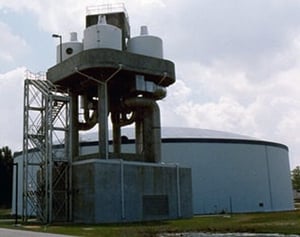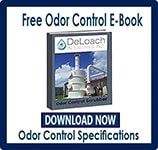 A Biological Odor Control Scrubber Is Just One Of Many Different Types Of Available Technologies to treat air emissions that may contain harmful gases.
A Biological Odor Control Scrubber Is Just One Of Many Different Types Of Available Technologies to treat air emissions that may contain harmful gases.
This class of equipment commonly falls into a category referred to as “Odor Control Scrubbers” and they are utilized to remove dangerous or noxious odors from an air stream. The Biological Odor Control System has gained popularity among many end users such as municipal operators due to the reduced operating cost and more simplistic operating requirements. A typical chemical odor control scrubber often requires two or more chemical additives and more instrumentation is required to maintain system performance. With the additional chemicals required and instrumentation comes the need for more hands-on maintenance, calibration, and safety requirements which increases the operating costs and workload of the operator.
A Biological Odor Control System relies on active bacteria cultures that recirculate within a water stream and flow across a random packed media bed that is beneficial to the bacteria culture.
During the process of metabolizing harmful gases such as Hydrogen Sulfide (H2S) the biological odor control system requires only the addition of Caustic to control and balance the pH and additional water makeup to replace what has been consumed through evaporation or during the blowdown process to eliminate solids. There are several different types of odor control and chemical wet scrubbers, industrial air scrubbers on the market today and each provides a solution for the treatment of noxious or corrosive gases and odors in the industry. And even though Biological scrubbers are commonly utilized in municipal applications for the treatment of hydrogen sulfide (H2S) gases that were produced by a water or wastewater treatment process there are times when a Biological Scrubber does not provide the best solution for treatment. When there are wide or rapidly changing concentrations in the ppm (parts per million) level then a Biological Scrubber will have difficulties balancing and acclimating fast enough to prevent a breakthrough. As an example, In water treatment, there is a treatment process referred to as “degasification” which strips the hydrogen sulfide gas from the water, and then the concentrated H2S gas is exhausted from the tower through an exhaust port. When the concentration rises above 1 ppm for hydrogen sulfide gas then the levels become both noxious to the surroundings as well as corrosive. Many times, the levels range from 3-7 PPM in concentration with Hydrogen Sulfide and pose a serious health threat, noxious odor, and corrosive environment demanding capture and treatment. When utilizing an Odor Control Scrubber such as a Biological Scrubber the gases are pulled or pushed through an air duct system that is connected to the Biological Scrubber inlet or suction side of the blower. The same process is utilized when treating Hydrogen Sulfide (H2S) gases that were captured at a wastewater treatment process. These gases may have been generated from a source such as the wastewater treatment plant, lift station, or master head-works facility. When captured the gases are also conveyed in a similar manner to the Biological Odor Control Tower for treatment.
So how does a Biological Scrubber work?
A Biological Odor Control Scrubber is in fact a ecosystem all to itself. The biological scrubber relies upon an initial seeding of tiny microorganisms (bacteria) which attach themselves to the internal media substrate or packing providing both a place to attach and to breed and multiply all the time coming in direct contact with the contaminated air. The bacteria are utilized to break down and digest contaminants, and it feeds on the contaminants as a food source which allows it to not only live but continue to grow and multiply.
When utilizing a Biological Odor Scrubber for hydrogen sulfide (H2S) treatment and removal the by-product that is produced during the reaction is a waste in the form of Sulphuric Acid which is produced as the Sulphur is consumed as a food source. The Sulphuric acid waste lowers the pH of the recirculating water and can create an unhealthy
environment for the bacteria to live and thrive. Therefore, to safeguard the bacteria colony and equipment the Biological Scrubber requires that caustic or another form of a base be added to buffer the water and maintain a healthy pH environment. The captured gas containing contaminants is typically pushed in a “Forced Draft” method into the bottom of a vertical Biological Tower Scrubber much like the gas enters any other type of chemical scrubber or other types of single or dual pass odor control scrubber. The gas stream then travels upward and passes over a media bed that has been cultured to grow live microorganisms on its surface. In a way you could say that a biological odor control scrubber already has “artificial intelligence” because of the millions of microbes colonies it supports. Unlike a traditional chemical scrubber or an ammonia scrubber the biological media bed is specially designed to support the bacteria colony growth and allow air movement with the least amount of back pressure. In addition, the biological scrubber has far fewer media packing required to treat the contamination in the air stream because the contaminant is being consumed and digested as opposed to oxidized.
Quite often the actual ability to remove the odor is not the most important factor behind the technology selection.
There are several different methods of treating odors in wastewater applications, but this short overview focuses primarily on biological odor control scrubbers. The most prevalent types on the market today to treat hydrogen sulfide (H2S) are either “chemical” or “biological” and both types have been widely used over the past decade in municipal, industrial, and petroleum markets. DeLoach Industries a leader in odor control and off-gas treatment designs and manufactures a variety of systems and is now incorporating artificial intelligence (AI) into their systems to further improve component-to-component communications and reporting on all critical functions. Imagine an operator is alerted if there is too much acid or not enough caustic in a supply tank in advance or having the scrubber contact the local supplier or support facility to respond before a problem becomes critical.
When choosing what type of scrubber, it is best to first understand the parameters of the air waste stream you need to treat. It is always recommended to have the odor gases analyzed to understand the total loading rate and what type of chemicals are creating the odorous gases and to work with manufacturers with design experience. Many times, you will find methane and hydrogen sulfide combined with other organics so understanding the chemical matrix of the gas is the first step in the selection process.
Make sure you obtain more than just one air sample over several time periods.
Before you make the selection of not only what technology to use for odor control but also the correct design and size of the odor control scrubber or air emission scrubber if treating another form of volatile organic chemical (VOC) gas stream. If after you collect your data, you see that you have concentrations that have wide variations over a day or even an hour with more than a 5% change then a chemical scrubber may be your best choice. Biological scrubbers perform best when the concentrations remain steady and do not fluctuate. When concentrations change rapidly the biological growth cannot adjust fast enough so the scrubber will experience a “break-through” of untreated gases unless it is a two-stage scrubber with a carbon polishing unit.
If the concentration levels fluctuate, are extremely high, have a wide variety of compounds, or contain any type of contaminant that may be harmful to the bacteria colony in the gas mixture then a chemical scrubber (single or dual pass) utilizing caustic or chlorine (for hydrogen sulfide) is often the best selection. The other two key components of the selection process are the anticipated annual operating cost of the scrubber and what type of service will the scrubber receive. If the scrubber is located where there is not an active operator, and it may be left at times unattended then this can drive the decision back towards selecting a biological scrubber that has fewer components that need maintaining and typically only requires caustic for pH control and occasionally a nutrient feed supply. It is always best to gather as much information on the specific location and obtain good analytical data before making the final section process. For more information or to learn more contact the professionals at DeLoach Industries Inc. at (941) 371-4995.



